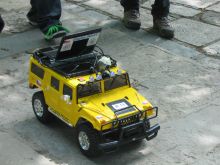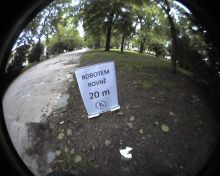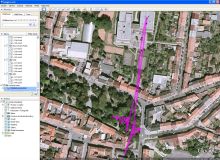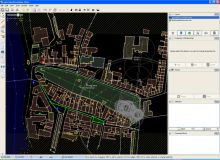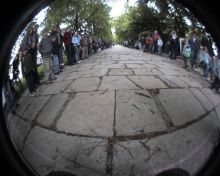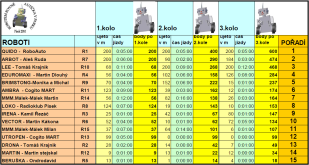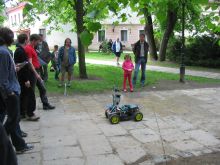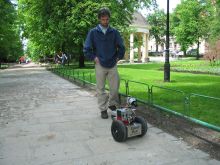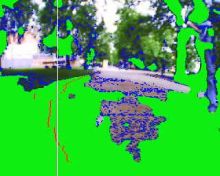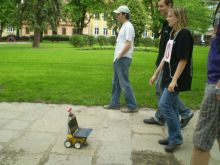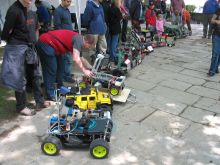Robotem rovně 2010
An outdoor competition of autonomous robots in Písek
The second year of "robotem rovně" (freely translated as go straightforward with robots) took part on May 22nd 2010 in Palackého sady, Písek. The event is organized by Radioklub Písek, aiming to increase robotics awareness in general public and to attract youth to technology. Entrants compete in two categories: robots and cars (robots without any sensors). The goal is to get as far as you can on a straight path, but it’s not nearly as easy to do, as it appears to be.
Rules
The goal of the competition: “To let the robot drive through the track without
any interaction with his owner or anyone else and to stay on the pathway at all
times. The road is about 3 meters wide and 300 meters long.” That’s just an
excerpt from the rules, which you can find at
Radioklub Pisek official
website.
The robots competed in three rounds and in a given order, which has been
determined by their velocity, measured at the approval (a test if the robot can
pass at least a meter long track). The faster robots went first and the slower
later, so they wouldn’t have to redundantly pass each other. The time
difference between the starts was two minutes, so they went relatively quickly
one after another.
A point was given for every meter the robot successfully drove, and the total
from all the rounds was the final score.
First impressions
When I saw Radioklub Pisek had this competition last summer, I thought of it as
a Robotour’s rival. But I see it way differently now – “Robotem rovně” (RR)
could be an ideal preparation race for Robotour. RR gives a chance to complete
beginners and mainly, lots of experience that you can use at Robotour. It was
not a coincidence, that many teams from Robotour came to this event, to dust
off their robots and train.
The event was very well organized and you could see that this wasn’t the first
one, that Radioklub Pisek held. Even the relatively fast tempo of the
competition was acceptable – observers weren’t bored, something was going on
all the time, and the competitors also had a good time those three rounds.
Competition difficulty
Even though it doesn’t seem at first sight, the competition difficulty is
pretty high. To be more precise, the further you want to go, the harder it is.
Almost all the cars and robots make it 10 meters. The width to length ratio of
3m to 10m gives you about 17 degrees range, so it’s no real problem to point
your vehicle that way.
If your ambitions are a little bit higher, you need a bit of luck, or some
sensors. If you were thinking about GPS, you can give up already. There are
some beautiful, huge trees in the park and even though you have signal from up
to 9 satellites, the error isn’t going to be below 5 meters. I think that a
demonstration sample from NMEA at Google maps (see pic.) will give you an idea.
Necessary to say, the worst GPS position was on the start (then at least led
the same way as the road), but you can forget about telling on which side of
the road you are. After the import to OpenStreetMap, you can clearly see the
uncertainty level (circles).
Probably the next sensor, that comes to your mind, is a compass. That will
propel you way further, but some surprise will show up also. Firstly, you’ll
most likely have just a 2D compass, because they’re cheaper and more available.
Which wouldn’t matter much, but you have to know what tilting does to the
sensor. The road starts sloping downwards and, even if your compass can handle
this, is like any other road slightly tilted to one side because of the rain.
Aside the tilt of the compass, which can be compensated, pay attention to the
cables and the sewers hidden underneath the road, they will turn your compass
into a roulette. So, you can use one, but it would be best to combine with
odometry and gyroscopes.
The only remaining thing from commonly used sensors, is camera. The race
consisted of three rounds, and each one of them was unique. The weather at 10
a.m. was cloudy, at 11 a.m. rainy and at 12.a.m. the sun was shining sharp.
How’s Radioklub Pisek doing that, so you could train in all possible weather
conditions, I don’t know .
About 100 meters from the start, there’s a past for camera too. You will arrive
on a small, open atrium, and now search, kiddo. There was a little unclarity in
the rules, whether the robot can use the side ways: path is path, but I guess
the organizers meant to stay on the main path. Well, it isn’t simple.
But a proof, that you can reach the end, brought us Roboauto, that got the
maximum possible score. The road was 300m last year, but this time it was cut
down to 200m because of excavation works.
Results
The table of results is taken from the article
robotem-rovne-2010-uspesne-za-nami
R1 — Quido
Tomáš Ondráček/Roboauto
We took the competition in Písek as an opportunity to test our new platform:
robot Quido based on an RC model wheelframe. It used to be a second car
following a target on the lead “Karlík”, but we have upgraded it to work
autonomously.
From cooperation with FIT VUT in Brno, our team received lidar SICK LMS 100 for
the Sick Robot Day 2010 competition. We attached it to Quido not statically,
but to a turning hinge, so that it could turn during the ride, and cover most
of the area this way. Other than a camera we also used an odometer and a
compass. We turned off the GPS for the race, because it wasn’t necessary and it
would probably just complicate everything. For the same reasons, the front
sonar was turned off.
The driving software was the same we used at Robotour. Lidar and camera took
care of way detection, and the information was aggregated into a 2D map, in
which the robot planned his way using a reactivating algorithm. No global map
was necessary, considering the spirit of the competition.
To make the robot not to turn any undesired way on crossroads and large paved
areas, we added an option to set a preferred stable direction in the way
planner (which otherwise changes dynamically along the position in the RNDF
map).
Last Friday night before the competition we arrived to the park in Písek with
an intention to try the road once and to “smooth tune constants” from the
recording whole night long. To our surprise Quido went forth and back the whole
way without any doubts, so we could go to check the city square and some local
restaurants :). On Saturday the same thing repeated, Quido had no malfunctions,
so we ended up getting the maximum number of points.
The competition is, in my opinion, a good preparation for this year’s Robotour
in autumn and can be a nice first public test for beginning roboticians.
Radioklub Pisek did a great job in organizing this year, took care of nice
weather, and a big thanks belongs to them for that.
R3 — Irena
Kamil Řezáč/Sirael
It might sound defeatistly, but I didn’t come to Písek to win. I took the
competition primarily as something that will make me finish the robot in time.
Which I had, with a couple of reductions, been able to do, but I didn’t have
time to put together some advanced sensors or algorithms. So I decided to
create a very simple algorithm – to control the driving unit (turning of the
front wheels) according to the compass – basically a P regulator. To avoid
problems with the absolute value of azimuth, the error caused by compass
tilting and so on, I sampled and averaged the data from after the start from
the compass (50 samples) and I drove by that value.
Originally I planned to not change the algorithm (which was tested one evening
on the sidewalk in front of my house) at all. That didn’t go very well, the
regulation loop was oscillating more and more. Despite all that, I started the
first round with the original program, a poor result (25 m) was corresponding.
So I reduced the “strengthening” of the regulation loop, the robot calmed down
and the distance passed almost doubled (42 m). Because I saw the robot trying
to turn right a little, I set it it turned slightly left the last round and the
result was another increase in score (80m). The robot could go a couple meters
beyond that, but his destiny has been cut off by a collision with the 80m
sign…
I think this is the best (or close to it), that a “blind” robot can do, and it
surpassed my expectations by far (best test try result was 42m).
R4 — Eduro Maxi
Martin Dlouhý/Eduro Team
This was the first of the outdoor competitions this year for “Maxík”. It’s
still a baby, which had driven his first meter on Monday in a kitchen, then a
couple more meters after closing the bottom on Wednesday, and finally on
Saturday, it went on his first race.
Robot was homologed using version 0 – go straight using the odometry. Version 1
then combined compass and version 2 added data from a camera and GPS. In the
end, the robot was using a customized version 2, he drove straight for 1m, used
a combined data from camera and the compass, turned the right way, and went
straight for another meter. No rush, but you could easily see when the sensors
started to feel, that the robot is going off the road.
The “Robotem rovně” was a great competition. It provoked us to make the robot
work, so it will hopefully have a chance to score some points at
Field Robot Event. A week after that is
RoboOrienteering, and well,
Robotour 2010 in Bratislava in autumn and
SICK
Robot Day in Germany. Once again, huge thanks belong to the organizers for a
great event.
R7 — ARbot
Aleš Ruda/ARbot
The robot went through a big changeover after last year’s Robotour. New, more
accurate GPS, AHRS instead of a compass, new optics on the camera, writing
parts of the SW into assembly, a new barrel holder and a lot of little things.
Unfortunately, the MD23 motor units started to stiffen. Subsequently I found
out, that the cause were high voltage peaks in the 5V supply branch. Two months
of suffering came to an end in the beginning of May, when I upgraded to MD25.
Last day before the competition, the robot started moving again, some errors in
SW had been fixed and he even drove through a curvy way towards my house, so
“Let’s go!” to Písek in the morning.
Little of time, no space to be a hero. The strategy was, that a simple camera
will keep the robot on the track and sonar will assist with obstacles. It
worked for Robotour, anyways.
Quickly test the robot in local ambience and to the start of the first round.
3, 2, 1, start. The robot started moving, but instead of going straight on the
way, he “drunkishly” went from side to side, but he made it to the end.
Greeeeat. What’s with the weaving, though? Oh, I forgot the camera lens
cover.
I tried to make it go with the camera between rounds, but the results weren’t
good. Robot went off the road very soon. I couldn’t fix the road detection
algorithm. I tried to make the AHRS work, but didn’t face much success. So, if
it worked once, why not twice more? Robot will go according to the sonar. Next
round 90 and 184 meters. Good job. I wouldn’t believe this if someone told it
to me, but it’s true. I saw it with my own two eyes.
I think that this competition was a great start of the outdoor robot contests.
Thanks to organizers for the attitude.
R9 — Brimstone
Michal Eliáš and Monika Svědirohová
The “Robotem rovně” competition presented to us the first experience with
outdoor navigation. The wheelcase of the robot is Monika’s
Žluťásek, I was left with the algorithms and track
planning. I used a convolution principle from the webcamera, according to which
our robot drove, no other sensors were used. The principle is to drive through
the park manually, when the camera takes pictures at a given rate, while the
picture isn’t saved as a whole, just as vertical columns of information
calculated from the picture. Then on the competition the robots takes pictures
at the same rate, and compares them to ones from before. This method is very
memory and processor demanding, it needs at least an ARM7 level processor. We
have been able to go 152 meters, but testing before, we always passed the whole
track. The reason for not passing the track was a vulnerability of the
algorithm to spectators standing alongside the track. We came fifth in the end,
which is a great success, considering the fact, that the first test of the
algorithm was made in Písek.
R11 — Ambra, R13 - UTrooper
Jiří Iša/Cogito MART
Our faculty (MFF UK) has bought a new outdoor robotic wheelcase this year –
Utrooper. The goal (achieved) for Písek’s “Robotem rovně” was to test it in a
competition and to find some of it’s attributes and flaws. Flaws were the
bigger piece, but that can be expected with a new untested wheelcase.
The other robot taking part in the competition was Ambra – a customized RC
Hummer, originally built for Robotou 2009. Ambra went through a big hardware
change this year. So it’s basically a new robot’s premiere. Even this robot
showed a nice flaw, after two pretty successful rounds. But altogether Ambra
drove pretty well, plus got the vote of the 2nd vicemiss from the spectators!
We recommend the “Robotem rovně” competition to teams, that find Robotour too
difficult, but also teams, that have bigger ambition, but have a new robot.
Thanks to the organizers for a well held event in a beautiful neighbourhood
Final words
We recommend the “Robotem rovně a.k.a Autíčka v parku” competition warmly to
everybody. Other than a good event it is a great place to meet robotics and
roboticians, and full afternoon is free, so you can chat a bit. If you missed
this event, the next outdoor autonomous robots contest is
RoboOrienteering in Rychnov nad
Kněžnou. Finally, if you’re from Písek or its surroundings and robots are one
of your interests or hobbies, don’t be shy to contact
Radioklub Písek, they’ll be glad to assist you, or take
you into their team.
References:
- Organizers website: http://www.kufr.cz/
Send email to the editors
Your message could not be sent
but you can also reach us at webmaster-at-robotika.cz
Your message was successfully sent.
You need to turn on javascript to submit this form.
